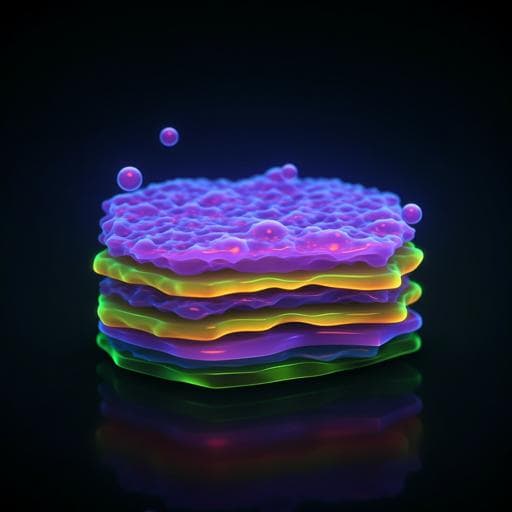
Engineering and Technology
Addressing the effects of gas adsorption on monolayers beyond charge population analysis: the case of WS₂
M. G. Bianchi, F. Risplendi, et al.
This exciting research, conducted by Michele Giovanni Bianchi, Francesca Risplendi, Michele Re Fiorentin, and Giancarlo Cicero, delves into the effects of oxygen gas adsorption on the optoelectronic properties of WS₂ monolayers. Discover a novel approach emphasizing the role of sulfur vacancies in charge transfer – a must-read for enthusiasts of 2D materials!
~3 min • Beginner • English
Introduction
Two-dimensional semiconducting monolayers such as WS₂ are promising for quantum information, metrology, imaging, and optoelectronics due to their direct band gap (~2 eV) and scalable synthesis (MBE, CVD). WS₂ monolayers are typically n-type and highly sensitive to ambient gases because of their large surface-to-volume ratio. Among air components, O₂ most strongly affects conductivity and photoluminescence (PL), decreasing conductivity and enhancing PL in air relative to vacuum by reducing free-electron density and favoring neutral exciton formation over negative trions. While chemisorption of O₂ can occur under high laser power or long exposure, the commonly observed PL changes at standard conditions are attributed to spontaneous physisorption. Most theoretical studies consider pristine surfaces and infer charge transfer from charge population analyses (CPA). However, synthesized 2D materials host defects—particularly sulfur vacancies (V_S)—which alter adsorption and electronic properties. Moreover, CPA often reports small, scheme-dependent charge transfers that are difficult to relate to measurable carrier concentration changes, and frequently neglects the intrinsic n-doping of WS₂. This motivates a physically grounded framework that incorporates intrinsic n-type behavior, variable defect densities, and multiple adsorbates/coverages, and that predicts measurable changes in band occupancy and optoelectronic properties. The present work addresses this gap by applying a charged-defect formalism to molecular adsorption on WS₂, explicitly including V_S and intrinsic n-doping, to clarify the atomistic mechanism of electron transfer underlying PL enhancement in air.
Literature Review
Prior experimental studies showed that O₂ exposure reduces conductivity and modulates PL in WS₂ monolayers, with enhanced neutral exciton emission in air compared to vacuum. Chemisorption contributions to PL changes become significant only under high-power/long-irradiation conditions; thus, physisorption is considered the primary mechanism under typical conditions. Theoretical investigations of gas adsorption on 2D materials frequently focused on pristine surfaces and used charge population analysis (CPA) to infer charge transfer, often without accounting for intrinsic n-doping. Defects in WS₂, especially sulfur vacancies, are prevalent and strongly influence adsorption, electronic, and catalytic properties, enhancing reactivity toward gases such as H₂, O₂, CO₂, and NO₂. Previous works suggested acceptor-like behavior of adsorbed O₂ but lacked a consistent link to band occupancy, and CPA-derived charge transfers are partition-scheme dependent and not easily mapped to carrier concentrations. Advanced band-structure treatments (e.g., hybrid functionals) refine absolute gap values but relative defect transition levels are reasonably captured at the GGA level, supporting the use of a charged-defect formalism for adsorption-induced charge transfer.
Methodology
Ab initio simulations based on spin-polarized Density Functional Theory (DFT) were performed using Quantum ESPRESSO with norm-conserving pseudopotentials and the rev-vdW-DF2 exchange-correlation functional to capture dispersion interactions in physisorption. Plane-wave cutoff was 75 Ry. Brillouin zone sampling used a 5×5×1 Monkhorst–Pack grid for the WS₂ unit cell and was scaled for supercells. A vacuum spacing of 20 Å was used. Large supercells (5×5 to 7×7) with a single sulfur vacancy (V_S) and/or a single adsorbed molecule (O₂, N₂) were modeled. Intrinsic n-type character was mimicked by adding extra electrons to the supercell. Energies of charged supercells were corrected using sxdefectalign2d. Adsorption energies E_ads(*+M,q) were computed for neutral and negatively charged states (q = 0, −1) as differences of total energies of adsorbed and clean systems plus isolated molecule energies and electrostatic corrections. Gibbs free energies of formation ΔG[C](E_F, P_M) for configurations C (V_S, V_S+O₂, V_S+N₂, O₂ on pristine) in charge states q = 0, −1 were computed at T = 298 K, including molecular chemical potentials derived from DFT energies with enthalpy/entropy corrections (thermochemical tables) and, for adsorbates, entropic contributions modeled via the hindered translator approach. Standard air partial pressures were used: P_N2 = 0.8 atm, P_O2 = 0.2 atm (N₂-only case at 1 atm). Charge transition levels ε_{0/−1}[C] were obtained from ΔG[C] for q = 0 and −1. From ΔG, site coverage fractions θ[C] for each configuration and charge state were computed via a partition function over all configurations. A semiconductor charge-balance formalism determined equilibrium Fermi level E_F by enforcing neutrality among band carriers and charged defects/adsorbates, including a surface density of sulfur vacancies n_V (10¹⁰–10¹³ cm⁻²) and an n-type electron source term n (10¹⁰–10¹³ cm⁻²) to represent intrinsic doping/substrate effects. Using the density of states of pristine WS₂ and Fermi–Dirac statistics, free electron densities in vacuum, N₂, and air were obtained from the self-consistent E_F. Photoluminescence (PL) implications were assessed by relating the ratio I(X⁰)/I(X⁻) to free-electron density and Fermi level through a trion binding energy factor, enabling computation of the relative enhancement R_gas/vac = (X/X⁻)_gas/(X/X⁻)_vac. Electronic structure analyses (band structures, PDOS) characterized in-gap states and their occupancy for pristine, V_S, and adsorbed configurations, in neutral and negatively charged conditions. Wavefunction isosurfaces for vacancy-induced states further probed charge redistribution upon adsorption.
Key Findings
- O₂ on pristine WS₂ does not accept electrons upon physisorption: The charge transition level for O₂ on the pristine surface lies at ε_{0/−1}[+O₂] ≈ 2.15 eV relative to E_VBM, above the conduction band minimum (E_CBM ≈ 1.89 eV). The negatively charged adsorbed state is unstable (positive adsorption energy), and PDOS shows the O₂ LUMO-like anti-bonding state remains unoccupied in both neutral and negatively charged supercells.
- Sulfur vacancies are essential for charge transfer: For V_S, ε_{0/−1}[V_S] ≈ 1.75 eV. O₂ adsorption at V_S stabilizes the negatively charged state and shifts ε_{0/−1}[V_S+O₂] to ≈ 1.69 eV, about 80 meV below ε_{0/−1}[V_S] and ε_{0/−1}[V_S+N₂]. This favors electron trapping in the presence of O₂ at vacancy sites in n-doped samples.
- Adsorption energetics: On pristine WS₂, O₂ physisorption has E_ads ≈ −100 meV (neutral) and is unstable when negatively charged. At V_S, O₂ adsorption strengthens upon charging: E_ads ≈ −150 meV (q=0) and ≈ −240 meV (q=−1). N₂ at V_S shows E_ads ≈ −140 meV (q=0) and ≈ −150 meV (q=−1), with nearly unchanged interaction upon charging and charge transition level nearly coincident with bare V_S.
- Environment-dependent charging of vacancy complexes: Coverage/charge-state analysis shows that in intrinsic samples (E_F ~ midgap) all V_S-related configurations are neutral (θ⁰ ≈ 100%) regardless of environment; upon raising E_F (n-doping), samples in air (O₂ present) transition to negatively charged states at lower E_F than in vacuum or N₂, indicating enhanced electron trapping due to O₂@V_S.
- Free-electron density reduction in air: Solving charge balance over realistic ranges n_V, n (10¹⁰–10¹³ cm⁻²) shows that exposure to air can reduce free-electron density by up to a factor ~2 relative to vacuum, most prominently for high vacancy density and moderate n-doping. In pure N₂, electron density is essentially unchanged from vacuum.
- PL consequences: The neutral exciton to trion intensity ratio (X/X⁻) is enhanced in air by up to ~3.5× relative to vacuum, consistent with experiments, with the largest effect at higher V_S densities. In N₂, enhancement is minor (~1.1×), confirming O₂@V_S as the driver of PL modulation.
- Electronic structure signatures: For O₂@V_S in the negatively charged state, the lowest in-gap state becomes occupied with substantial O contribution (spin-down p orbitals), indicating partial charge transfer to the molecule and charge redistribution between WS₂ and O₂. Wavefunction isosurfaces show delocalization from the vacancy toward O₂ upon adding an electron. In contrast, N₂@V_S shows no contribution to vacancy states in either charge state.
- CPA comparison: Conventional CPA on neutral supercells fails to distinguish between active (O₂) and inert (N₂) adsorbates and, even with added electrons, suggests small transfers in other configurations that are not clearly linked to measurable carrier-density changes. The charged-defect/charge-balance formalism provides a quantitative, experimentally relevant picture.
Discussion
The study resolves the long-standing question of how air exposure, particularly O₂, modulates the optoelectronic response of n-type WS₂ monolayers. By embedding molecular physisorption into the charged-defect formalism and explicitly including intrinsic n-doping and sulfur vacancies, the work demonstrates that charge transfer does not occur for O₂ on pristine WS₂ and only becomes effective when O₂ binds at V_S sites in n-doped samples. This mechanism lowers the free-electron density and enhances neutral exciton emission while suppressing trions, quantitatively matching experimental PL trends and their dependence on vacancy density. The analysis reconciles band-occupancy considerations with adsorption thermodynamics and charge transition levels, linking atomistic energetics to macroscopic carrier densities via charge balance. The findings clarify why inert N₂ has negligible effect and why vacancy engineering modulates air sensitivity, guiding strategies for optoelectronic performance control and gas sensing. Moreover, the approach overcomes the limitations of CPA by producing directly measurable predictions (carrier densities, PL ratios) and is generalizable to other 2D materials and adsorbate/defect systems.
Conclusion
This work introduces a robust, general framework to analyze gas-induced carrier modulation in 2D semiconductors by combining DFT-based adsorption energetics with a charged-defect charge-balance formalism. Applied to WS₂, it shows that O₂ physisorption at sulfur vacancies, together with intrinsic n-doping, is necessary to drive electron transfer from the conduction band into localized surface states, reducing free-electron density and enhancing neutral-exciton PL. O₂ on pristine WS₂ is ineffective, and N₂ is inert even at vacancy sites. The methodology yields quantitative predictions consistent with experiments and provides electronic-structure signatures (PDOS and wavefunctions) of the charge redistribution. Future research can extend this framework to other defects (e.g., complex vacancies, substitutional impurities), other adsorbates and partial pressures, temperature dependencies, substrate effects, and dynamical processes (e.g., photoinduced chemisorption) to further tailor and predict gas–2D material interactions.
Limitations
- Band-gap underestimation at the GGA level may affect absolute positions of band edges; however, relative defect transition levels are robust and results are expected to hold with hybrid functionals.
- The study focuses on sulfur vacancies and on O₂ and N₂ adsorbates under standard conditions; other defects (e.g., complex vacancies, substitutions), adsorbates, and coverages are not explicitly explored.
- Intrinsic n-type behavior is modeled via an electron source term rather than explicit donor defects or explicit substrate interactions; substrate and dielectric environment effects are not included.
- Chemisorption processes, which may become relevant at high laser powers or long exposures, are not the primary focus.
- Supercell modeling with single defects/adsorbates neglects defect–defect and adsorbate–adsorbate interactions at higher densities; kinetic aspects and time dependence are not treated.
- Temperature is fixed at room temperature (298 K); variations with temperature are not mapped out.
Related Publications
Explore these studies to deepen your understanding of the subject.







